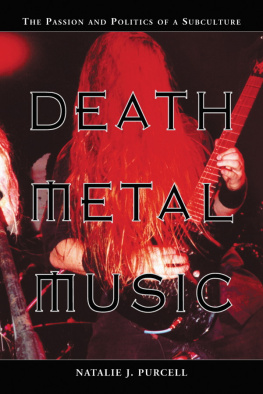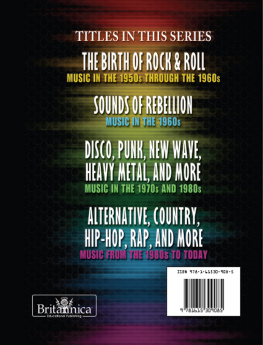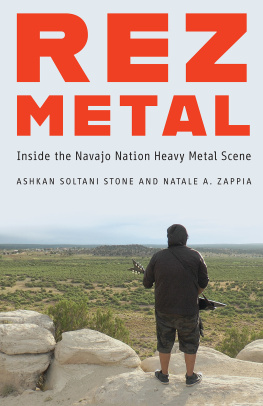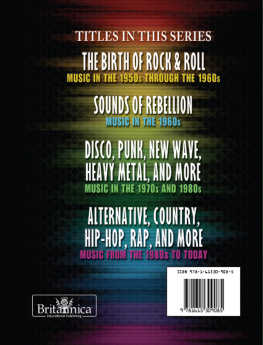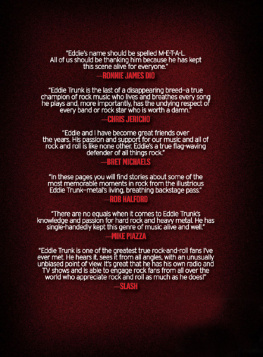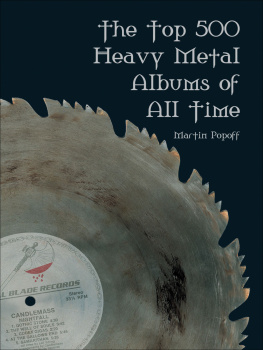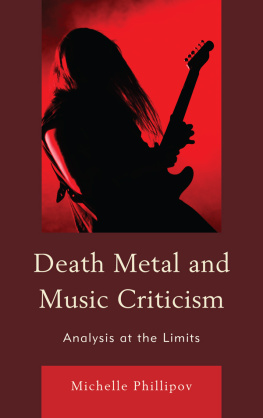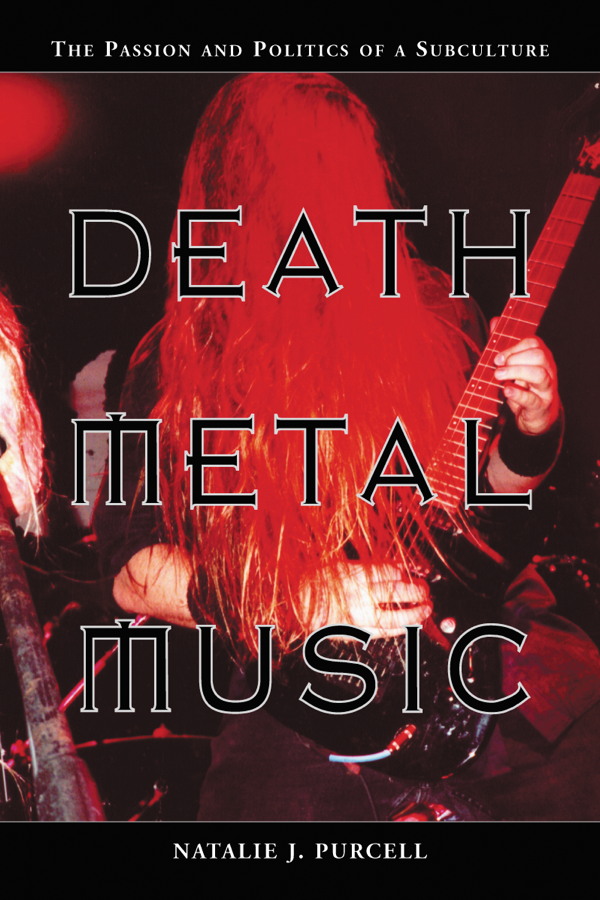
Table of Contents
Library of Congress Cataloguing-in-Publication Data
Purcell, Natalie J.
Death Metal music : the passion and politics of a subculture / Natalie J. Purcell.
p. cm.
Includes bibliographical references and index.
ISBN-13: 978-0-7864-1585-4
1. Heavy metal (Music)History and criticism. I. Title.
ML3534.P91 2003
781.66dc21 2003007616
British Library cataloguing data are available
2003 Natalie J. Purcell. All rights reserved
No part of this book may be reproduced or transmitted in any form or by any means, electronic or mechanical, including photocopying or recording, or by any information storage and retrieval system, without permission in writing from the publisher.
On the front cover: Sean McGrath of Impaled.
McFarland & Company, Inc., Publishers
Box 611, Jefferson, North Carolina 28640
www.mcfarlandpub.com
Acknowledgments
This book is dedicated to all those in the Death Metal scene who generously gave their time and effort to this project. Thank you so much to the research assistants and to every interviewee who devoted time and thought to this endeavor: Pete, Killjoy, Kyle, King, Paul, Jeremy, John L., John G., Erik, Seth, Adrianne, Rob, John D., Brian, and Dana.
Special thanks are extended to Matt Medeiros for supporting this project from the start, to Jason Netherton and Matt Harvey for providing a wealth of advice and information, to Iris Duran for lending a critical eye and a helping hand, and to Bill for his help and generosity.
Above all, this project owes a debt to my political science professors at Seton Hall University, whose open-minded enthusiasm and support made it possible. I am especially indebted to Dr. Mary Boutilier, Dr. Jo-Renee Formicola, and Dr. Jeffrey Togman.
On a more personal note, this book was composed in a time of significant stress, and there were many times when I doubted my ability to get through it. Were it not for the kindness of my dear friends from SHU and from good old Kearny, N.J., this book wouldnt be here. The legal advice of Linda Mowad, Janice Sylvia, Janet Bayer, Griselda Morillo Manjarres, Bridget Bocchino, and others was invaluable to this project. Bridget and Griselda, your wisdom and intelligence have meant the world to me. Mikey R., I thank you for your kindness and your inspiring spirit. Mike H., you have helped me in so many ways; your listening ear, your wise words, and your pure heart are gifts I am so grateful to have received.
Sean, Nicole, Sandy, Ricky, Sergio, my grandparents, my parents, my sister, and so many others also deserve my gratitude, for they played small but deeply significant roles in the completion of this work.
Preface
This book invites readers to visit the music, the experience, and the fans of a dark subculture. Rich in interviews with major scene personalitiesfrom rock stars and radio hosts to the average adolescent fanit approaches the subculture from every inside angle. At the same time, the book addresses current tendencies of politicians, conservative groups, and typical Americans to attribute youth violence and the destruction of social values to entertainment forms with violent themes. Death Metal is among the most disturbing and despised forms of such entertainment.
Is it possible that a thorough investigation of the Death Metal scene might cast doubt upon the usual assumptions about Death Metal fans? If so, then it is possible to challenge censorship advocates. To this end, the book investigates the demographic trends, attitudes, philosophical beliefs, ethical systems, and behavioral patterns within the scene.
Finally, this work seeks to situate the Death Metal scene in the larger social order. With its extreme depictions of violence, gore, and seemingly all that is antisocial, the Death Metal community proves an intense microcosm for the subcultural phenomenon and lends insight into the psychological and social functions of forbidden or illicit entertainment forms. This analysis of the Death Metal scene provides a key to comprehending deviant tendencies in contemporary culture at large.
The Death Metal scene extends far beyond the boundaries of the United States, and many of the most important contributors to the Death Metal scene are European. Nonetheless, the sample for this study was taken from American Death Metal musicians and fans, and the book will focus on the Death Metal scene in the United States.
The book is divided into six primary sections. Part I discusses the music itself, with an emphasis on the lyrical content that is most often criticized. The nature of Death Metal music is analyzed and the different sub-genres of the scene are explored. This section also looks at the activity and atmosphere of Death Metal shows themselves, as well as the appearance and behavior of show attendees.
Part II describes the history of the Death Metal scene. It is divided into three chapters marking significant periods in the history of Death Metal: 19841988, 19891994, and 19952002. This history is related through the experiences of the major bands of each period as the scene evolved. Much of this information is derived from interviews with key musicians and scene personalities.*
Part III introduces the politics of censorship and delves into the controversy surrounding the scene. The first chapter, The Skeleton in Americas Closet, describes popular opinions about the destructive potential of Death Metal music and the negative behavior of its fans. The second and third chapters of the section describe the politics of media censorship in the United States and speculate about censorship prospects for Death Metal music and other forms of violent entertainment.
Part IV tests the validity of the opinions of would-be censors using data obtained through research. This lengthy section analyzes the research findings, their implications, and their relationship to existing literature on metal fans. The second chapter of the section contains a report and analysis of all of the demographic data gathered from the surveys, interviews, and direct observations. It addresses topics such as age, gender, race, socioeconomic status, education levels, employment rate, family situation, and depression. A third chapter focuses on the attitudes of Death Metal fans toward social institutions and life in general. This chapter analyzes views on religion, marriage, politics, and capitalism, as well as perceived chances of success and ideological orientation. The fourth chapter in Part IV contains data on the philosophical and ethical traits of the study population. Personal metaphysical views, faith, ethical systems, and metal philosophy itself are examined here. The remaining chapters in the section are perhaps the most socially relevant chapter of this study. They look at the behavior of metal fans, reporting statistics on sexual activity, alcohol use, drug use, and violent behavior.
In assessing the findings reported in Part IV, it is important to keep an accurate understanding of the nature of the study, its methods, and its aims. There should be no attempts to generalize on the basis of the information gathered and reported here. Field research, snowball sampling, and haphazard nationwide surveys proved the best methods to use for the purposes of this study. These methods, however, are not reliable tools in the social sciences and do not permit the drawing of even vague conclusions. Therefore, the purpose of this study is not to draw conclusions, but rather to raise new questions and to cast doubt on some existing and unwarranted conclusions about the population of Death Metal fans.
Next page
